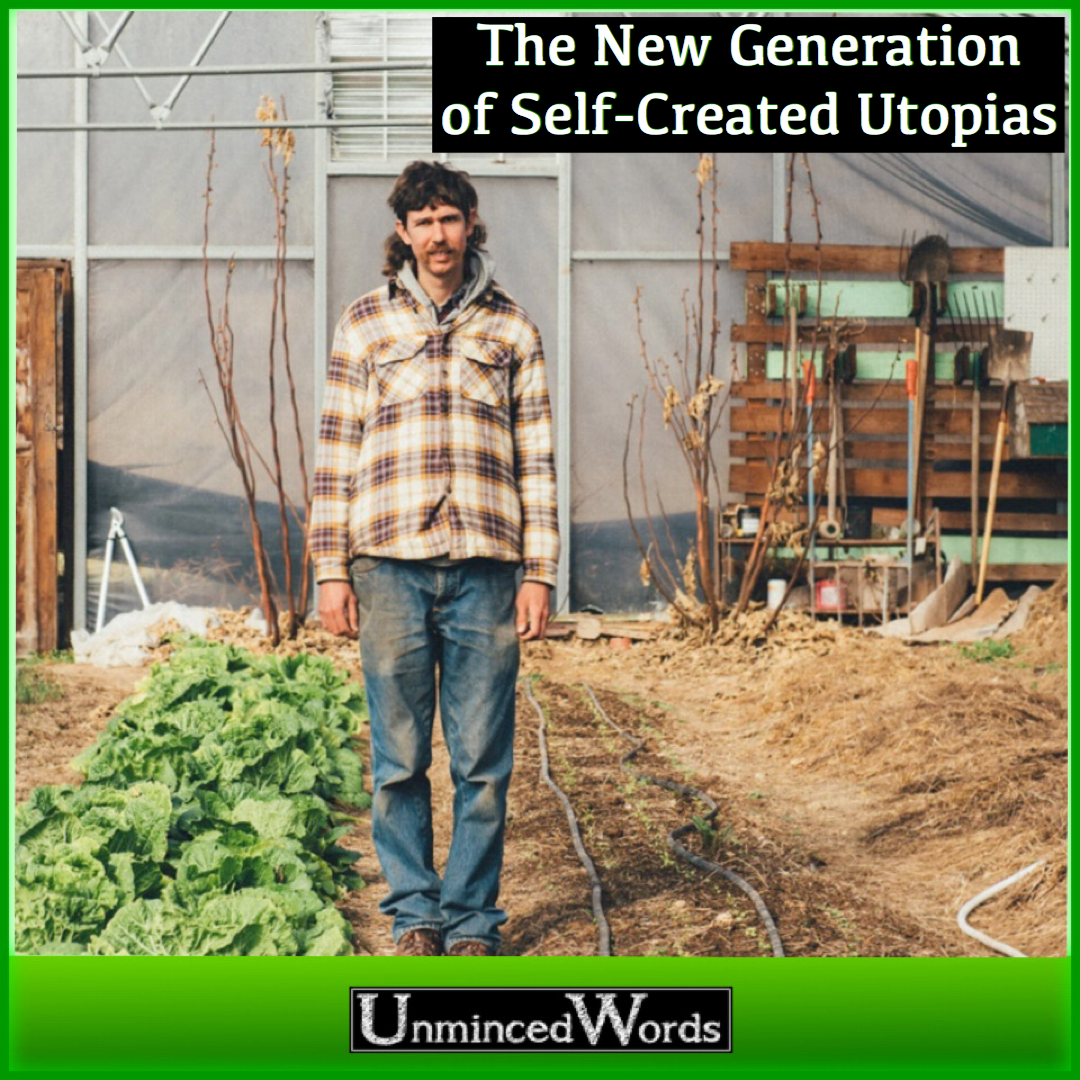
The New Generation of Self-Created Utopias
As so-called intentional communities proliferate across the country, a subset of Americans is discovering the value of opting out of contemporary society.
THE EAST WIND COMMUNITY is hidden deep in the Ozarks of southern Missouri, less than 10 miles from the Arkansas border, surrounded by jagged hills and tawny fields. Getting there requires traversing country roads that rise, dip and twist through chicken-wire-fenced farmsteads and grazing pastures cluttered with rusty agricultural equipment until you reach 1,145 acres of largely undeveloped highland forest, where cedar, oak, pine and mulberry create a dense canopy. Beneath that are 27 buildings and structures, including four large dormitories, nine personal shelters, a kitchen and dining facility, an automobile shop, a nut butter manufacturing plant and a cold-storage warehouse, all built over the years by the community since its founding in 1974. Outside, farm animals — six piglets, 50 chickens, several dozen brown-and-white cows — crunch through the carpet of winter leaves.
Nearby, a pair of women make their way down a muddy field, one pushing a wheelbarrow, to a weathered-gray wooden barn where they’ll draw gallons of milk from their dairy cows. A reedy man with a long, sandy mullet presses a chain saw to the base of a tree trunk. People stop each other on the dirt paths, asking about the understaffed forestry program, or recounting anecdotes about going into town to sort through credit card charges. Everyone has somewhere to be, yet no one is hurried. There are no smartphones in sight. The collective feels like a farm, a work exchange and a bustling household rolled into one, with much work to be done but many hands to be lent.
East Wind is what its 72 residents call an intentional community, a modern descendant of the utopian colonies and communes of centuries past where individuals share everything from meals, chores and living space to work, income, domestic responsibilities and the burden of self-governance. The term intentional community dates to the late 1940s, when the Inter-Community Exchange — an organization formed in Yellow Springs, Ohio, in the wake of World War II to help promote peaceful, cooperative living arrangements (in the hope of eradicating war altogether) — changed its name to the Fellowship of Intentional Communities; the founders felt the new title better conveyed the deliberateness with which these groups were assembling. The members of East Wind, for example, range in age from infancy to 76: Some have lived here for more than three decades, but around half of the population is part of a new wave, people in their late 20s and early 30s who joined in the last four years. These newer residents moved to East Wind to wean themselves off fossil fuels, grow their own food, have a greater say in how their society is run and live in less precarious financial circumstances.
According to Sky Blue, the 39-year-old executive director of the Foundation for Intentional Community and a former member of the Virginia-based commune Twin Oaks, which was founded in 1967, the number of intentional communities listed in the FIC’s directory nearly doubled between 2010 and 2016 (the last year the directory was published), to roughly 1,200. Although the number of people living in these communities is hard to pin down — the demographic is often deliberately off the grid — Blue estimates that there are currently around 100,000 individuals residing in them. “There’s an obvious growth trend that you can chart,” he said; millennials “get this intentional community thing more than people in the past.”
THE UNITED STATES HAS been a laboratory for experiments in alternative living since its founding. The English Puritans and Pilgrims who, wishing to escape the oppression and persecution of the Church of England, fled to America in the early 17th century to create smaller societies where they could live according to their faith were followed, notably, by the Transcendentalists in 1830s New England, who sought to distance themselves from the ruthlessness of the Industrial Revolution and instead lead a life driven by Romantic ideals.
In 1841, George and Sophia Ripley, Unitarians inspired by that Transcendentalist ethos, bought a 188-acre parcel of hills and pinewood forests in the West Roxbury neighborhood of Boston, where they started one of the country’s earliest and most influential utopian communities, called Brook Farm. To fund the project, the couple created a joint stock company with 10 other initial investors; they sold shares for $500, promising investors 5 percent of annual profits, which they hoped to earn by selling handmade clothing, collecting tuition from a private school run by Sophia and offering tours to curious outsiders for a small fee. George even wrote to Ralph Waldo Emerson, the founder of Transcendentalism, in 1840, in hopes that the movement’s putative leader might join or otherwise invest in his social experiment, arguing that, at Brook Farm, “thought would preside over the operations of labor, and labor would contribute to the expansion of thought” in order to achieve “industry without drudgery.”
Because Brook Farm aspired to so many goals — abolishing the class system, promoting gender parity, dividing labor equitably, privileging intellectual and leisure pursuits, promoting self-improvement — it attracted social reformers and early feminists, theologians and authors (Nathaniel Hawthorne was a founding member). Though it peaked at just 32 people and was officially shuttered in 1847 after being devastated by debt, smallpox and a fire, it became an American model for subsequent utopian projects. Over the following decades, more communities, including the Amana Colonies in Iowa and the Oneida Colony in upstate New York, served as sanctuaries from materialism and modernity. By the early 1900s, though, many of these had collapsed under the weight of financial pressures, ideological strife and tensions between the fantasy of social enlightenment and the realities of manual labor and working-class living conditions.
It wasn’t until the decades after World War II, when large numbers of Americans began questioning their nation’s sociopolitical and environmental policies, that the desire to create alternative societies was renewed, leading to the “hippie communes” that would become indelible features of the 20th-century cultural landscape. Places like Strawberry Fields in Southern California, The Farm in central Tennessee and Drop City in rural Colorado encapsulated the radical freedom, social experimentation and consciousness expansion that came to define the 1960s and 1970s. By borrowing openly from the psychedelic movement, artist collectives such as Ant Farm, Fluxus and Art Workers’ Coalition, as well as subcultures like the Merry Pranksters, the Nature Boys and, too, the rising environmentalist movement — some of which had emerged in response to the Vietnam War — these new communes tapped into an iconoclastic strain of society that embraced socialist ideals and Eastern philosophical tenets (including detachment, spontaneity and pacifism), rejecting many of the prevailing middle-class values of the time, including the primacy of the nuclear family and the zeal for conspicuous consumption (upon joining The Farm, for instance, all members took vows of poverty). Many of these communes, lacking any codified organizational structure and struggling to cultivate steady income, eventually faltered, but they had already achieved a kind of dubious cultural immortality, ultimately becoming the nation’s measure for the alternative living arrangements and utopian enterprises that followed.
WHILE HIPPIE COMMUNES have become a cliché, their DNA has nevertheless been passed down to some of today’s intentional communities. Consider Cedar Moon, tucked inside a state park on seven acres of farmland near the outskirts of Portland, Oregon. Up until 2004, the property was rented out to a rotating cast of free-spirited artists, activists and musicians, who lived in two old-growth timber-frame houses. When a developer offered the owner $1.5 million to convert the land into a housing development, longtime residents banded together to save it from a fate that would not only have left them homeless, but was antithetical to their values. In February 2005, 16 residents raised $125,000 in a month to buy the developer’s option contract — effectively removing the immediate threat — and then scrambled to secure the $1.5 million required to buy the property (nearly half of which, ironically, came from bank loans) over the next year.
In addition to the two original houses and a ramshackle barn, the property now consists of a sauna, yurt, outdoor kitchen, performance stage, composting-toilet outhouse and elaborate, brightly-painted gazebo that the 20 residents, who built everything themselves, call the T-Whale. Several of the structures are made of cob, a composite of clay, sand and straw that was popularized in England in the late Middle Ages and is extremely energy-efficient because of its high thermal mass. Almost everyone earns income outside of the community — Cedar Moon is not technically a commune according to the FIC definition — and current members, primarily people in their 30s and 40s and their children, include several teachers, a therapist, a director at a nonprofit and an accountant. While everyone keeps their finances separate, they share groceries, appliances (there’s one washer and dryer) and operate based on consensus. “It’s such an anticapitalist thing, just to share,” said Brenna Bell, an environmental lawyer who lives there. “Our economy relies on growth. It relies on people consuming. And we are going very intentionally in the opposite direction.”
Members must contribute 10 hours of labor each week, which might include tending the apple orchard, milking the herd of goats or cooking for the community (living expenses total around $600 a month). Cedar Moon isn’t off the power grid, but its residents have a dramatically smaller carbon footprint than the average American because they share resources, grow much of their own produce, use composting toilets and heat their homes with wood-burning stoves. Vinnie Inzano, a 30-year-old graduate student in marriage and family therapy, moved to Cedar Moon a year and a half ago because he didn’t want to be “plugged into systems that are causing collapse,” he said; he feels the community offers a better way of coexisting with the environment, “combating the story of extraction.”
Earthaven, which consists of 329 densely forested acres within North Carolina’s Blue Ridge Mountains, and was founded in 1994 by 18 people in their 30s and 40s, takes sustainability even more seriously. The community of roughly 100 people, which member Chris Farmer described as “overeducated suburban refugees,” is entirely off the grid. Several solar panels, a micro-hydropower system and smaller photovoltaic installations scattered throughout the property’s hills provide all the necessary energy for residents, who are divided into 11 smaller neighborhoods, each with anywhere from one to 14 homes made of earthen plaster, straw bale and lumber felled on the land. Rachel Fee, a 39-year-old herbalist, moved to Earthaven in 2017 after five years living outside Asheville, N.C. She wanted a more communal lifestyle that fit her ideals and didn’t push her to work relentlessly; here, she’s no longer “inundated with the idea that productivity is your self-worth,” she said. But Fee was also clear that her living arrangement was uniquely challenging, requiring a willingness to fully cohabit with others. Her 800-square-foot, reddish-brown straw-bale home sits on a gently sloping hill that she shares with 20 people living in nine structures huddled closely together. The residents get their water from the same spring and bathe in the same bathhouse. “This is not an idealistic situation,” she said. “It’s not running away from the world and sticking our head in the sand — it’s reinventing the wheel.”
IN 2017 BJORN GRINDE and Ranghild Bang Nes, researchers with the Norwegian Institute of Public Health, co-authored a paper on the quality of life among North Americans living in intentional communities. Along with David Sloan Wilson, director of the evolutionary studies program at Binghamton University, and Ian MacDonald, a graduate assistant, they contacted more than 1,000 people living in 174 communities across the U.S. and Canada and asked them to rate their happiness level on the Satisfaction With Life Scale (SWLS), a globally recognized measurement tool. They compared these results to a widely cited 2008 study by the psychologists William Pavot and Ed Diener, which surveyed past studies that used the scale to analyze 31 disparate populations — including Dutch adults, French-Canadian university students and the Inuit of northern Greenland — and discovered that members of intentional communities scored higher than 30 of the 31 groups. Living in an intentional community, the authors concluded, “appears to offer a life less in discord with the nature of being human compared to mainstream society.” They then hypothesized why that might be: “One, social connections; two, sense of meaning; and three, closeness to nature.”
Though many residents of intentional communities are undoubtedly frustrated by climate inaction and mounting economic inequality, others are joining primarily to form stronger social bonds. According to a study published last year by researchers at the University of California San Diego, more than three-quarters of American adults now experience moderate to high levels of loneliness — rates that have more than doubled over the last 50 years. Despite rising housing costs across the country, more Americans are living alone today than ever before. As Boone Wheeler, a 33-year-old member of East Wind, told me, “There are literal health consequences to loneliness: Your quality of life goes down due to lack of community — you will die sooner.”
Last February, Sumner Nichols, a 29-year-old who grew up in Pennsylvania and moved to East Wind four years ago, invited me to visit the community, which was originally established by a group of men and women who had been living at Twin Oaks and decided they wanted to use the knowledge and experience they accumulated to start their own commune. After amassing a handful of followers during stops in Vermont and Massachusetts, the fledgling group eventually settled in the Ozarks because the land was cheap and adjacent to water. The residents, whose commitment to industry has helped ensure East Wind’s longevity, crafted rope hammocks by hand in partnership with Twin Oaks in the 1970s before launching their own jarred nut-butter business in the early 1980s; their products, which are mainly sold across the Midwest, typically gross between $2 million and $3 million annually. All adult members of East Wind must work 35 hours per week in various capacities, whether cooking, gardening, milling lumber, maintaining infrastructure, looking after the animals or working in the manufacturing plant. Because it’s a relatively modest schedule, residents have enough free time to cultivate personal passions: Nichols practices wildlife photography, while other members produce and record music, study herbal medicine and create ceramics using the community kiln.
Even in the dead of winter, the property is stunning, with its undulating textures of ridges, glades and limestone escarpments. It was obvious how living here could reconnect people to the land, letting them hike, climb, swim and harvest in a way that is beyond reach for most Americans. As we passed a three-story dormitory painted Egyptian blue, Nichols told me that, as a college student in the late 2000s, he tumbled down what he calls the “climate change research hole,” reading websites that pored over grim scientific projections about an increasingly warmer planet. He’d joined the Bloomington, Indiana, chapter of the Occupy movement for a while, but saw the blaze of indignation dwindle to fumes without any lasting political victories. Afterward, Nichols felt wholly disillusioned by the corporations and government organizations that he felt had a stranglehold on his life. “It’s going to go how it goes,” he recalled thinking, so “how do you want to live in it?” After discovering several intentional communities online — many find East Wind and others through simple Google searches — he concluded that joining one was “just a more comfortable way of living right now.”
As evening approached, we met several residents who had decided to take advantage of the unseasonably warm weather by gathering at one of East Wind’s “swimming holes” — sandbanks that run alongside Lick Creek and provide easy swimming access. As the setting sun glinted off the gently rippling water, one 31-year-old resident, who goes by the mononym Indo and who had been at East Wind for five and a half years, discussed what brought him to the community: “When I was in Babylon,” he said, using the term members of East Wind half-sarcastically deploy to refer to mainstream society, “all I did was follow economics.” While the residents have similar issues and problems as people outside of an intentional community, he added, here they were free from the cutthroat hierarchies that dominated the broader culture. “Instead of your boss telling you what to do, it turns into a social relationship,” he said. “We’re just reframing it from a different perspective.” Indeed, if there is any sense of romanticism running through the community — one that harks back to Brook Farm’s belief in a daily life in which individual freedoms are more fully realized and moral convictions more faithfully observed — it lies in the notion that none of us, actually, have to be complicit to political, social and economic forces with which we don’t agree.
But unless people are raised in an intentional community or something closely resembling one, they must still find a way to relinquish whatever perch they’ve already carved out for themselves before moving to one of these places. The choice is reminiscent of a line from Henry Thoreau’s “Walden” (1854), in which the Transcendentalist author assures the reader that if he were to follow a more intrepid path, he “will pass an invisible boundary; new, universal, and more liberal laws will begin to establish themselves around and within him; or the old laws will be expanded, and interpreted in his favour in a more liberal sense…. He will live with the license of a higher order of beings.” There will always, however, be the daunting task of letting go.
THE EAST WIND COMMUNITY is hidden deep in the Ozarks of southern Missouri, less than 10 miles from the Arkansas border, surrounded by jagged hills and tawny fields. Getting there requires traversing country roads that rise, dip and twist through chicken-wire-fenced farmsteads and grazing pastures cluttered with rusty agricultural equipment until you reach 1,145 acres of largely undeveloped highland forest, where cedar, oak, pine and mulberry create a dense canopy. Beneath that are 27 buildings and structures, including four large dormitories, nine personal shelters, a kitchen and dining facility, an automobile shop, a nut butter manufacturing plant and a cold-storage warehouse, all built over the years by the community since its founding in 1974. Outside, farm animals — six piglets, 50 chickens, several dozen brown-and-white cows — crunch through the carpet of winter leaves.
Nearby, a pair of women make their way down a muddy field, one pushing a wheelbarrow, to a weathered-gray wooden barn where they’ll draw gallons of milk from their dairy cows. A reedy man with a long, sandy mullet presses a chain saw to the base of a tree trunk. People stop each other on the dirt paths, asking about the understaffed forestry program, or recounting anecdotes about going into town to sort through credit card charges. Everyone has somewhere to be, yet no one is hurried. There are no smartphones in sight. The collective feels like a farm, a work exchange and a bustling household rolled into one, with much work to be done but many hands to be lent.
East Wind is what its 72 residents call an intentional community, a modern descendant of the utopian colonies and communes of centuries past where individuals share everything from meals, chores and living space to work, income, domestic responsibilities and the burden of self-governance. The term intentional community dates to the late 1940s, when the Inter-Community Exchange — an organization formed in Yellow Springs, Ohio, in the wake of World War II to help promote peaceful, cooperative living arrangements (in the hope of eradicating war altogether) — changed its name to the Fellowship of Intentional Communities; the founders felt the new title better conveyed the deliberateness with which these groups were assembling. The members of East Wind, for example, range in age from infancy to 76: Some have lived here for more than three decades, but around half of the population is part of a new wave, people in their late 20s and early 30s who joined in the last four years. These newer residents moved to East Wind to wean themselves off fossil fuels, grow their own food, have a greater say in how their society is run and live in less precarious financial circumstances.
According to Sky Blue, the 39-year-old executive director of the Foundation for Intentional Community and a former member of the Virginia-based commune Twin Oaks, which was founded in 1967, the number of intentional communities listed in the FIC’s directory nearly doubled between 2010 and 2016 (the last year the directory was published), to roughly 1,200. Although the number of people living in these communities is hard to pin down — the demographic is often deliberately off the grid — Blue estimates that there are currently around 100,000 individuals residing in them. “There’s an obvious growth trend that you can chart,” he said; millennials “get this intentional community thing more than people in the past.”
THE UNITED STATES HAS been a laboratory for experiments in alternative living since its founding. The English Puritans and Pilgrims who, wishing to escape the oppression and persecution of the Church of England, fled to America in the early 17th century to create smaller societies where they could live according to their faith were followed, notably, by the Transcendentalists in 1830s New England, who sought to distance themselves from the ruthlessness of the Industrial Revolution and instead lead a life driven by Romantic ideals.
In 1841, George and Sophia Ripley, Unitarians inspired by that Transcendentalist ethos, bought a 188-acre parcel of hills and pinewood forests in the West Roxbury neighborhood of Boston, where they started one of the country’s earliest and most influential utopian communities, called Brook Farm. To fund the project, the couple created a joint stock company with 10 other initial investors; they sold shares for $500, promising investors 5 percent of annual profits, which they hoped to earn by selling handmade clothing, collecting tuition from a private school run by Sophia and offering tours to curious outsiders for a small fee. George even wrote to Ralph Waldo Emerson, the founder of Transcendentalism, in 1840, in hopes that the movement’s putative leader might join or otherwise invest in his social experiment, arguing that, at Brook Farm, “thought would preside over the operations of labor, and labor would contribute to the expansion of thought” in order to achieve “industry without drudgery.”
Because Brook Farm aspired to so many goals — abolishing the class system, promoting gender parity, dividing labor equitably, privileging intellectual and leisure pursuits, promoting self-improvement — it attracted social reformers and early feminists, theologians and authors (Nathaniel Hawthorne was a founding member). Though it peaked at just 32 people and was officially shuttered in 1847 after being devastated by debt, smallpox and a fire, it became an American model for subsequent utopian projects. Over the following decades, more communities, including the Amana Colonies in Iowa and the Oneida Colony in upstate New York, served as sanctuaries from materialism and modernity. By the early 1900s, though, many of these had collapsed under the weight of financial pressures, ideological strife and tensions between the fantasy of social enlightenment and the realities of manual labor and working-class living conditions.
It wasn’t until the decades after World War II, when large numbers of Americans began questioning their nation’s sociopolitical and environmental policies, that the desire to create alternative societies was renewed, leading to the “hippie communes” that would become indelible features of the 20th-century cultural landscape. Places like Strawberry Fields in Southern California, The Farm in central Tennessee and Drop City in rural Colorado encapsulated the radical freedom, social experimentation and consciousness expansion that came to define the 1960s and 1970s. By borrowing openly from the psychedelic movement, artist collectives such as Ant Farm, Fluxus and Art Workers’ Coalition, as well as subcultures like the Merry Pranksters, the Nature Boys and, too, the rising environmentalist movement — some of which had emerged in response to the Vietnam War — these new communes tapped into an iconoclastic strain of society that embraced socialist ideals and Eastern philosophical tenets (including detachment, spontaneity and pacifism), rejecting many of the prevailing middle-class values of the time, including the primacy of the nuclear family and the zeal for conspicuous consumption (upon joining The Farm, for instance, all members took vows of poverty). Many of these communes, lacking any codified organizational structure and struggling to cultivate steady income, eventually faltered, but they had already achieved a kind of dubious cultural immortality, ultimately becoming the nation’s measure for the alternative living arrangements and utopian enterprises that followed.
WHILE HIPPIE COMMUNES have become a cliché, their DNA has nevertheless been passed down to some of today’s intentional communities. Consider Cedar Moon, tucked inside a state park on seven acres of farmland near the outskirts of Portland, Oregon. Up until 2004, the property was rented out to a rotating cast of free-spirited artists, activists and musicians, who lived in two old-growth timber-frame houses. When a developer offered the owner $1.5 million to convert the land into a housing development, longtime residents banded together to save it from a fate that would not only have left them homeless, but was antithetical to their values. In February 2005, 16 residents raised $125,000 in a month to buy the developer’s option contract — effectively removing the immediate threat — and then scrambled to secure the $1.5 million required to buy the property (nearly half of which, ironically, came from bank loans) over the next year.
In addition to the two original houses and a ramshackle barn, the property now consists of a sauna, yurt, outdoor kitchen, performance stage, composting-toilet outhouse and elaborate, brightly-painted gazebo that the 20 residents, who built everything themselves, call the T-Whale. Several of the structures are made of cob, a composite of clay, sand and straw that was popularized in England in the late Middle Ages and is extremely energy-efficient because of its high thermal mass. Almost everyone earns income outside of the community — Cedar Moon is not technically a commune according to the FIC definition — and current members, primarily people in their 30s and 40s and their children, include several teachers, a therapist, a director at a nonprofit and an accountant. While everyone keeps their finances separate, they share groceries, appliances (there’s one washer and dryer) and operate based on consensus. “It’s such an anticapitalist thing, just to share,” said Brenna Bell, an environmental lawyer who lives there. “Our economy relies on growth. It relies on people consuming. And we are going very intentionally in the opposite direction.”
Members must contribute 10 hours of labor each week, which might include tending the apple orchard, milking the herd of goats or cooking for the community (living expenses total around $600 a month). Cedar Moon isn’t off the power grid, but its residents have a dramatically smaller carbon footprint than the average American because they share resources, grow much of their own produce, use composting toilets and heat their homes with wood-burning stoves. Vinnie Inzano, a 30-year-old graduate student in marriage and family therapy, moved to Cedar Moon a year and a half ago because he didn’t want to be “plugged into systems that are causing collapse,” he said; he feels the community offers a better way of coexisting with the environment, “combating the story of extraction.”
Earthaven, which consists of 329 densely forested acres within North Carolina’s Blue Ridge Mountains, and was founded in 1994 by 18 people in their 30s and 40s, takes sustainability even more seriously. The community of roughly 100 people, which member Chris Farmer described as “overeducated suburban refugees,” is entirely off the grid. Several solar panels, a micro-hydropower system and smaller photovoltaic installations scattered throughout the property’s hills provide all the necessary energy for residents, who are divided into 11 smaller neighborhoods, each with anywhere from one to 14 homes made of earthen plaster, straw bale and lumber felled on the land. Rachel Fee, a 39-year-old herbalist, moved to Earthaven in 2017 after five years living outside Asheville, N.C. She wanted a more communal lifestyle that fit her ideals and didn’t push her to work relentlessly; here, she’s no longer “inundated with the idea that productivity is your self-worth,” she said. But Fee was also clear that her living arrangement was uniquely challenging, requiring a willingness to fully cohabit with others. Her 800-square-foot, reddish-brown straw-bale home sits on a gently sloping hill that she shares with 20 people living in nine structures huddled closely together. The residents get their water from the same spring and bathe in the same bathhouse. “This is not an idealistic situation,” she said. “It’s not running away from the world and sticking our head in the sand — it’s reinventing the wheel.”
IN 2017 BJORN GRINDE and Ranghild Bang Nes, researchers with the Norwegian Institute of Public Health, co-authored a paper on the quality of life among North Americans living in intentional communities. Along with David Sloan Wilson, director of the evolutionary studies program at Binghamton University, and Ian MacDonald, a graduate assistant, they contacted more than 1,000 people living in 174 communities across the U.S. and Canada and asked them to rate their happiness level on the Satisfaction With Life Scale (SWLS), a globally recognized measurement tool. They compared these results to a widely cited 2008 study by the psychologists William Pavot and Ed Diener, which surveyed past studies that used the scale to analyze 31 disparate populations — including Dutch adults, French-Canadian university students and the Inuit of northern Greenland — and discovered that members of intentional communities scored higher than 30 of the 31 groups. Living in an intentional community, the authors concluded, “appears to offer a life less in discord with the nature of being human compared to mainstream society.” They then hypothesized why that might be: “One, social connections; two, sense of meaning; and three, closeness to nature.”
Though many residents of intentional communities are undoubtedly frustrated by climate inaction and mounting economic inequality, others are joining primarily to form stronger social bonds. According to a study published last year by researchers at the University of California San Diego, more than three-quarters of American adults now experience moderate to high levels of loneliness — rates that have more than doubled over the last 50 years. Despite rising housing costs across the country, more Americans are living alone today than ever before. As Boone Wheeler, a 33-year-old member of East Wind, told me, “There are literal health consequences to loneliness: Your quality of life goes down due to lack of community — you will die sooner.”
Last February, Sumner Nichols, a 29-year-old who grew up in Pennsylvania and moved to East Wind four years ago, invited me to visit the community, which was originally established by a group of men and women who had been living at Twin Oaks and decided they wanted to use the knowledge and experience they accumulated to start their own commune. After amassing a handful of followers during stops in Vermont and Massachusetts, the fledgling group eventually settled in the Ozarks because the land was cheap and adjacent to water. The residents, whose commitment to industry has helped ensure East Wind’s longevity, crafted rope hammocks by hand in partnership with Twin Oaks in the 1970s before launching their own jarred nut-butter business in the early 1980s; their products, which are mainly sold across the Midwest, typically gross between $2 million and $3 million annually. All adult members of East Wind must work 35 hours per week in various capacities, whether cooking, gardening, milling lumber, maintaining infrastructure, looking after the animals or working in the manufacturing plant. Because it’s a relatively modest schedule, residents have enough free time to cultivate personal passions: Nichols practices wildlife photography, while other members produce and record music, study herbal medicine and create ceramics using the community kiln.
Even in the dead of winter, the property is stunning, with its undulating textures of ridges, glades and limestone escarpments. It was obvious how living here could reconnect people to the land, letting them hike, climb, swim and harvest in a way that is beyond reach for most Americans. As we passed a three-story dormitory painted Egyptian blue, Nichols told me that, as a college student in the late 2000s, he tumbled down what he calls the “climate change research hole,” reading websites that pored over grim scientific projections about an increasingly warmer planet. He’d joined the Bloomington, Indiana, chapter of the Occupy movement for a while, but saw the blaze of indignation dwindle to fumes without any lasting political victories. Afterward, Nichols felt wholly disillusioned by the corporations and government organizations that he felt had a stranglehold on his life. “It’s going to go how it goes,” he recalled thinking, so “how do you want to live in it?” After discovering several intentional communities online — many find East Wind and others through simple Google searches — he concluded that joining one was “just a more comfortable way of living right now.”
As evening approached, we met several residents who had decided to take advantage of the unseasonably warm weather by gathering at one of East Wind’s “swimming holes” — sandbanks that run alongside Lick Creek and provide easy swimming access. As the setting sun glinted off the gently rippling water, one 31-year-old resident, who goes by the mononym Indo and who had been at East Wind for five and a half years, discussed what brought him to the community: “When I was in Babylon,” he said, using the term members of East Wind half-sarcastically deploy to refer to mainstream society, “all I did was follow economics.” While the residents have similar issues and problems as people outside of an intentional community, he added, here they were free from the cutthroat hierarchies that dominated the broader culture. “Instead of your boss telling you what to do, it turns into a social relationship,” he said. “We’re just reframing it from a different perspective.” Indeed, if there is any sense of romanticism running through the community — one that harks back to Brook Farm’s belief in a daily life in which individual freedoms are more fully realized and moral convictions more faithfully observed — it lies in the notion that none of us, actually, have to be complicit to political, social and economic forces with which we don’t agree.
But unless people are raised in an intentional community or something closely resembling one, they must still find a way to relinquish whatever perch they’ve already carved out for themselves before moving to one of these places. The choice is reminiscent of a line from Henry Thoreau’s “Walden” (1854), in which the Transcendentalist author assures the reader that if he were to follow a more intrepid path, he “will pass an invisible boundary; new, universal, and more liberal laws will begin to establish themselves around and within him; or the old laws will be expanded, and interpreted in his favour in a more liberal sense…. He will live with the license of a higher order of beings.” There will always, however, be the daunting task of letting go.
By Mike Mariani
Jan. 22, 2020
N.Y. Times
At www.UnmincedWords.com we create cool #gifts #optout #moving #utopia #unminced #livingalonetogether #thefuture #community #postcovid #apocalyptic #thinktank






























































